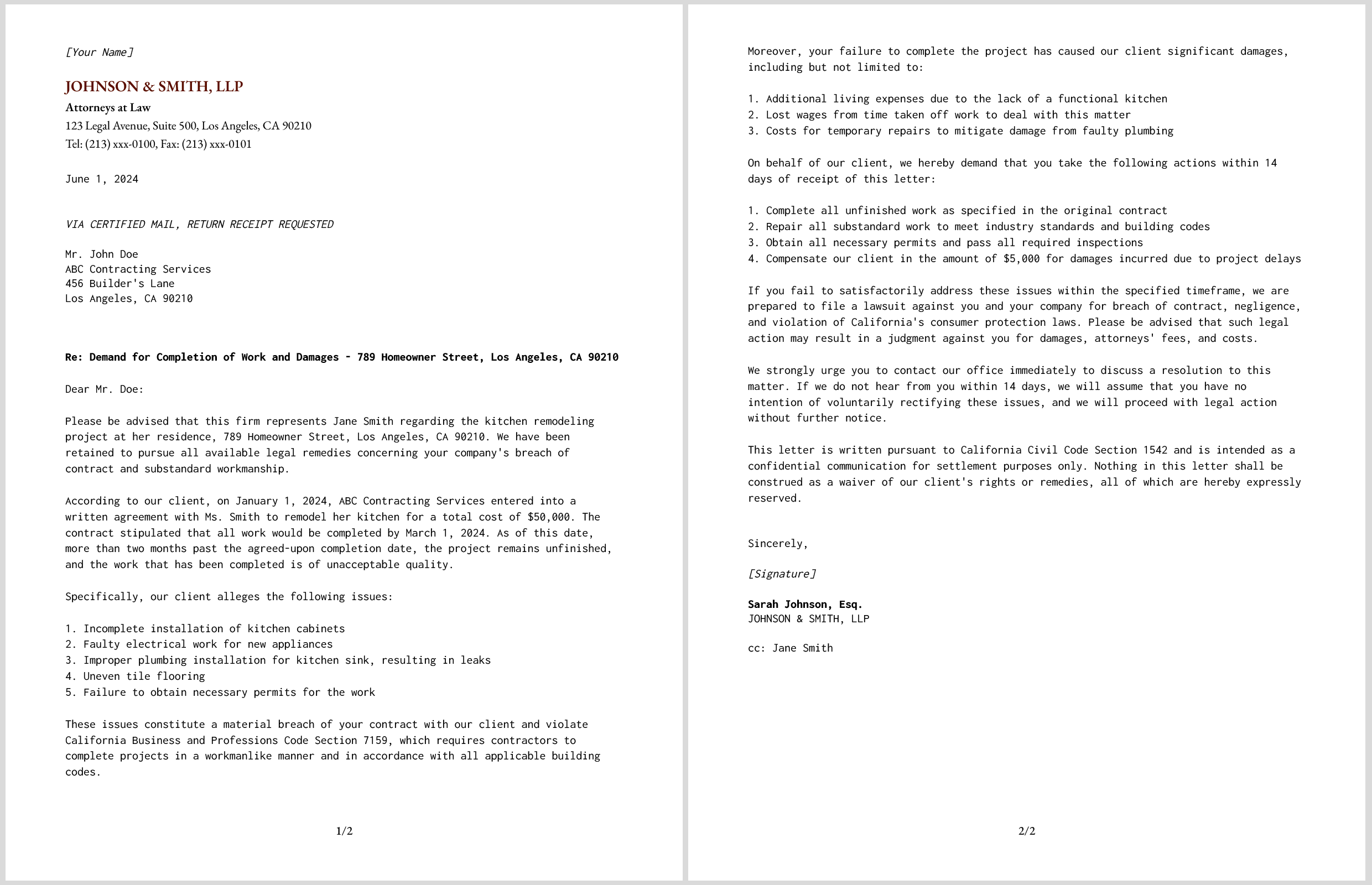
Imagine this: You’ve just spent $50,000 on a home renovation project, but your contractor left you with leaky pipes, uneven flooring, and electrical wiring that doesn’t meet code. You’re frustrated, out of pocket, and unsure what to do next.
If this sounds familiar, you’re not alone. Many California homeowners face similar issues with contractors, and sometimes, legal action is the only way to resolve them. This guide will walk you through the process of suing a contractor in California and what steps to take to prevent a full-blown lawsuit.
California Homeowner Rights
The Contractors State License Board (CSLB) regulates contractors in the state of California. According to California Business and Professions Code Section 7150-7159.14, contractors must follow specific rules when working with homeowners:
- Written Contracts:
For jobs over $500, contractors must provide a written contract. - Limited Down Payments:
Contractors can only ask for a down payment of 10% of the total job cost or $1,000, whichever is less. For example, for a $20,000 roofing job, the maximum down payment would be $20,000. - Work Specifications:
The contract must detail the work to be done. For example, if you’re having your kitchen remodeled, the contract should specify things like “Install 20 square feet of granite countertop” or “Replace existing sink with stainless steel double sink model XYZ.”
Steps to Take Before Suing Your Contractor
Before rushing to court, consider these steps:
- Document everything:
Keep all contracts, receipts, photos of the work, and any communication with the contractor.- Take before and after photos of the work area
- Save text messages or emails discussing the project
- Keep a log of phone calls, including dates and what was discussed
- Try to resolve the issue directly:
Speak with your contractor about the problems. For instance, if your new hardwood floors are warping, call the contractor and send pictures. Ask them to come and inspect the problem. - File a complaint with the CSLB:
The CSLB offers mediation services that might help resolve your dispute without going to court. You can file a complaint on their website or call (800) 321-CSLB (2752). For example, if your contractor abandoned the job halfway through, you could file a complaint detailing the work left unfinished. - Send a demand letter:
A demand letter from an attorney is a formal request for the contractor to remedy the situation. While you can write this letter yourself, having an attorney draft and send it is preferred.
Sending a Demand Letter to a Contractor
Hiring a lawyer to send a demand letter can be an effective way to resolve disputes without going to court. Here’s an example of what a demand letter might look like:

If the contractor doesn’t respond satisfactorily to your demand letter, at that point you can more confidently proceed with a lawsuit. Not sure where to ask a lawyer to send a demand letter? We can help get you a demand letter from a California-licensed lawyer for a low flat rate, just click below to get started right away.
Suing Without a Lawyer
If you decide to sue without a lawyer (known as filing “pro se”), here are the steps you’ll need to take:
- Determine the appropriate court:
In California, you can sue for up to $10,000 in small claims court. For larger amounts, you’ll need to file in the California Superior Court. For example, if your contractor did $8,000 worth of damage to your home, you could file in small claims court. But if the damages are $15,000, you’d need to file in superior court.
- File a complaint:
This document starts your lawsuit. You’ll need to clearly state your case against the contractor and what you’re seeking in damages. Example complaint language: “On [Date], I hired [Contractor Name] to remodel my kitchen for $20,000. The work was to be completed by [Date]. As of today, the kitchen is only half-finished, and the work that has been done is of poor quality. I am seeking $10,000 to cover the cost of completing the work properly.”
- Serve the contractor:
After filing, you must legally notify the contractor of the lawsuit. This is called “serving” the defendant.
- Prepare for court:
Gather all your evidence, including contracts, photos, and communication records. Practice presenting your case clearly and concisely. Create a timeline of events, compile before and after photos of the work, and organize all your correspondence with the contractor.
- Attend the hearing:
Present your case to the judge, who will decide based on the evidence presented.
Remember, while it’s possible to sue without a lawyer, contractor disputes can be complex. If you’re dealing with a large sum of money or a complicated case, it’s worth consulting with an attorney.
Suing With a Lawyer
Hiring a lawyer can make the process easier and potentially more successful. Here’s what to expect when suing with a lawyer:
- Initial consultation:
Most lawyers offer a free initial consultation. Use this time to explain your case and determine if the lawyer is a good fit.
- Case preparation:
Your lawyer will gather evidence, interview witnesses, and prepare legal documents.
- Filing the lawsuit:
Your lawyer will file the complaint and handle all necessary court filings.
- Discovery:
This is the process where both sides exchange information about the case. Your lawyer will handle requests for documents and depositions.
- Negotiations:
Many cases are settled before trial. Your lawyer will negotiate with the contractor’s attorney to try to reach a favorable settlement.
- Trial:
If a settlement isn’t reached, your lawyer will represent you in court, presenting your case to the judge or jury. Your lawyer might present expert testimony about the faulty installation, photos of the damage, and documentation of your attempts to resolve the issue with the contractor.
Taking Action: Protecting Your Rights and Investment in Home Improvement Projects
Suing a contractor in California can be a complex process, but it’s sometimes necessary to protect your rights and recover damages. Whether you choose to sue with or without a lawyer, being well-informed about the process can help you navigate it more successfully. Remember to document everything, try to resolve issues directly when possible, and be aware of the statute of limitations. With persistence and the right approach, you can hold contractors accountable for their work and protect your investment in your home.
